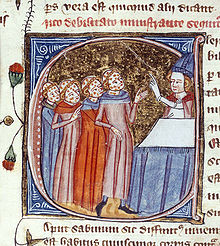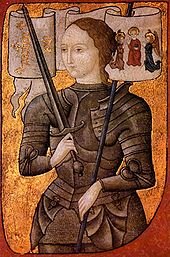Late Middle Ages
 The Late Middle Ages were a period initiated by calamities and upheavals. During this time, agriculture was affected by a climate change that has been documented by climate historians, and was felt by contemporaries in the form of periodic famines, including the Great Famine of 1315-1317. Medieval Britain was afflicted by 95 famines, and France suffered the effects of 75 or more in the same period. The Black Death, a disease that spread among the populace like wildfire, killed as much as a third of the population in the mid-14th century. In some regions, the toll was higher than one half of the population. Towns were especially hard-hit because of the crowded conditions. Large areas of land were left sparsely inhabited, and in some places fields were left unworked. Because of the sudden decline in available labourers, the price of wages rose as landlords sought to entice workers to their fields. Workers also felt that they had a right to greater earnings, and popular uprisings broke out across Europe. Even the king Louis I of Hungary was forced to stop his long war against the Kingdom of Naples in 1347, because of the deaths in the Italian region. The Black Death soon took the life of Louis I's wife, Margaret, daughter of the German emperor Charles IV, and as well few Hungarians, although the negative consequences of this disease in the Kingdom of Hungary were relatively mild.
The Late Middle Ages were a period initiated by calamities and upheavals. During this time, agriculture was affected by a climate change that has been documented by climate historians, and was felt by contemporaries in the form of periodic famines, including the Great Famine of 1315-1317. Medieval Britain was afflicted by 95 famines, and France suffered the effects of 75 or more in the same period. The Black Death, a disease that spread among the populace like wildfire, killed as much as a third of the population in the mid-14th century. In some regions, the toll was higher than one half of the population. Towns were especially hard-hit because of the crowded conditions. Large areas of land were left sparsely inhabited, and in some places fields were left unworked. Because of the sudden decline in available labourers, the price of wages rose as landlords sought to entice workers to their fields. Workers also felt that they had a right to greater earnings, and popular uprisings broke out across Europe. Even the king Louis I of Hungary was forced to stop his long war against the Kingdom of Naples in 1347, because of the deaths in the Italian region. The Black Death soon took the life of Louis I's wife, Margaret, daughter of the German emperor Charles IV, and as well few Hungarians, although the negative consequences of this disease in the Kingdom of Hungary were relatively mild.
Paradoxically, creative social, economic and technological responses emerged from this period of stress; these developments laid the groundwork for further significant change during the Early Modern Period. It was also a period when the Catholic Church was increasingly divided against itself. During the time of the Western Schism, the Church was led by as many as three popes at one time. The divisiveness of the Church undermined papal authority, and allowed the formation of national churches. State resurgence
The Late Middle Ages also witnessed the rise of strong, royalty-based nation-states, particularly the Kingdom of England, the Kingdom of France, and the Christian kingdoms of the Iberian Peninsula (Aragon, Castile, Navarre, and Portugal).
The long conflicts of this time, such as the Hundred Years' War fought between England and France, strengthened royal control over the kingdoms, even though they were extremely hard on the peasantry. Kings profited from warfare by gaining land.
France shows clear signs of a growth in royal power during the 14th century, from the active persecution of heretics and lepers, expulsion of the Jews, and the dissolution of the Knights Templar. In all of these cases, undertaken by Philip IV, the king confiscated land and wealth from these minority groups. The conflict between Philip and Pope Boniface VIII, a conflict which began over Philip's unauthorized taxation of clergy, ended with the violent death of Boniface and the installation of Pope Clement V, a weak, French-controlled pope, in Avignon. This action enhanced French prestige, at the expense of the papacy.
England, too, began the 14th century with warfare and expansion. Edward I waged war against the Principality of Wales and the Kingdom of Scotland, with mixed success, to assert what he considered his right to the entire island of Great Britain.
Both the Kings of France and the Kings of England of this period presided over effective states administered by literate bureaucrats, and sought baronial consent for their decisions through early versions of parliamentary systems, called the Estates General in France and the Parliament in England. Towns and merchants allied with kings during the 15th century, allowing the kings to distance themselves further from the territorial lords. As a result of the power gained during the 14th and 15th centuries, late medieval kings built truly sovereign states, which were able to impose taxes, declare war, and create and enforce laws, all by the will of the king. Kings encouraged cohesion in their administration by appointing ministers with broad ambitions and a loyalty to the state. By the last half of the 15th century, kings like Henry VII of England and Louis XI of France were able to rule without much baronial interference.
Hundred Years' War

The Hundred Years' War was a conflict between France and England lasting 116 years, from 1337 to 1453. It was fought primarily over claims by the English kings to the French throne and was punctuated by several brief and two extended periods of peace before it finally ended in the expulsion of the English from France, except for the Calais Pale. This series of conflicts is commonly divided into three or four phases: the Edwardian War (1337-1360), the Caroline War (1369�1389), the Lancastrian War (1415-1429), and the slow decline of English fortunes (1429-1453) after the appearance of Joan of Arc. Though primarily a dynastic conflict, the war gave impetus to ideas of both French and English nationality. Militarily, it saw the introduction of new weapons and tactics, which eroded the older system of feudal armies dominated by heavy cavalry. The first standing armies in Western Europe since the time of the Western Roman Empire were introduced for the war, thus changing the role of the peasantry. For all this, as well as for its long duration, it is often viewed as one of the most significant conflicts in the history of medieval warfare. Controversy within the Church
The troubled 14th century saw both the Avignon Papacy of 1305-1378, also called the Babylonian Captivity of the Papacy (a reference to the Babylonian Captivity of the Jews), and the so-called Western Schism that lasted from 1378 to 1418. The practice of granting papal indulgences, fairly commonplace since the 11th century, was reformulated and explicitly monetized in the 14th century. Indulgences became an important source of revenue for the Church, revenue that filtered through parish churches to bishops and then to the pope himself. This was viewed by many as a corruption of the Church. In the early years of the 15th century, after a century of turmoil, ecclesiastical officials convened in Constance in 1417 to discuss a resolution to the Schism.[Traditionally, councils needed to be called by the Pope, and none of the contenders were willing to call a council and risk being unseated. The act of convening a council without papal approval was justified by the argument that the Church was represented by the whole population of the faithful. The council deposed the warring popes and elected Martin V. The turmoil of the Church, and the perception that it was a corrupted institution, sapped the legitimacy of the papacy within Europe and fostered greater loyalty to regional or national churches. Martin Luther published objections to the Church. Although his disenchantment had long been forming, the denunciation of the Church was precipitated by the arrival of preachers raising money to rebuild the Basilica of Saint Peter in Rome. Luther might have been silenced by the Church, but the death of the Holy Roman Emperor Maximilian I brought the imperial succession to the forefront of concern. Lutherans' split with the Church in 1517, and the subsequent division of Catholicism into Lutheranism, Calvinism, and Anabaptism, put a definitive end to the unified Church built during the Middle Ages.European development
The fall of East and central Europe
In the end of the 15th century the Ottoman Empire advanced all over East Europe conquering eventually the Byzantine Empire and extending their control on the slavish states of the Balkans. Hungary became eventually the last bastion of the Latin Christian world, and fought for the keeping its rule on his territories during two centuries. After the tragic death of the young King Vladislaus I of Hungary during the Battle of Varna in 1444 against the Ottomans, the Kingdom without monarch was placed in the hands of the count John Hunyadi, who became Hungary's regent-governor (1446-1453). Hunyadi was considered by the pope as one of the most relevant military figures of the 15th century (Pope Pius II awarded him with the title of Athleta Christi or Champion of Christ), because he was the only hope of keeping a resistance against the Ottomans in Central and West Europe. Hunyadi succeeded during the Siege of Belgrade in 1456 against the Ottomans, which meant the biggest victory against that empire in decades. This battle became a real Crusade against the Muslims, as the Hungarian, Bohemian and Slavic peasants were motivated by the Franciscan monk Saint John of Capistrano, which came from Italy predicating the Holy War. The effect that it created in that time was one of the few main factors that helped achieving the victory. However the premature death of the Hungarian Lord left defenseless and in chaos that area of Europe.
As an absolutely unusual event for the Middle Ages, Hunyadi's son, Matthias, was elected as King for Hungary by the nobility. For the first time, a member of an aristocratic family (and not from a royal family) was crowned. The King Matthias Corvinus of Hungary (1458-1490) was one of the most prominent figures of this Age, as he directed campaigns to the west conquering Bohemia answering to the Pope's claim for help against the Hussite Protestants, and also for solving the political hostilities with the German emperor Frederick III of Habsburg he invaded his west domains (For the end of his life Matthew of Hungary also held the title of Duke of Austria). Matthew organized the Black Army of Hungary, composed of mercenary soldiers that is considered until the date as the biggest army of its time. Using this powerful tool, the Hungarian king led wars against the Turkish armies and stopped them during his reign. However, the Ottoman Empire grew in strength, and the Black Army of Hungary disappeared, leaving the Kingdom defenseless after the death of Matthew. At the same time, Hungary became under his reign the most important country where the Renaissance developed after the Italian states. Many sculptors, poets, musicians, painters, scientists moved to Hungary from all corners of Europe, gathering all in the court of the King. He established what was at the time of Europe's largest libraries, the Bibliotheca Corviniana, with over 3000 codices.
Hungary resisted until 1526 when the Ottoman armies won the Battle of Mohacs, and the Christian Kingdom lost his King Louis II of Hungary, falling in a serious crisis. The Protestant reform, and The American Continent's discovery left behind the matter of the Ottoman wars, and mutilated the medieval Europe leaving it without one of its most important Kingdoms. This episode is considered to be one of the final ones of the Medieval Times.